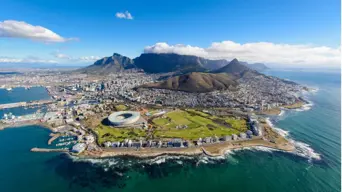Cape Town CBD can be 16°C hotter than other areas on hot days - study
The building-dense CBD and industrial areas are the most affected, according to the heat mapping study.

Bruce Whitfield talks to NWU's Professor Roelof Burger about the results of the study.
Due to the effects of climate change, extreme heat in South Africa poses significant risks across urban areas reports Heat Watch Cape Town.
And a recent study shows that on the hottest days in the Mother City, there is a 16.3°C difference between the warmest and coolest areas at the same time of day.
The building-dense CBD and industrial areas are the most affected.
The findings resulted from a multi-stakeholder citizen science study which included the City of Cape Town, the World Bank and community organisations.
Nine teams collected the data on a blazing hot day in February.
Climate change projections for Cape Town indicate that average temperatures, high heat days and heat waves are set to increase in length, frequency, and intensity, reports the City.
It's important that local government, together with other private and public sector partners, leads in tackling challenges of extreme heat, says Deputy Mayor, Eddie Andrews.
In general, temperatures can vary significantly region by region in a city based on factors like foliage cover, urban shading, and geographical factors like the proximity to the sea.
In Cape Town specifically, does Table Mountain play a big role in the heat trapping effect in parts of the city?
John Maytham talks to Professor Roelof Burger from the Unit for Environmental Sciences and Management at North-West University (NWU). He's also a member of the World Meteorological Organization's Expert Team on Weather Modification.
Prof. Burger says Cape Town probably presents an extreme case because of its particular geographic features.
"Not only do we have the mountain but we also have the ocean, so if we go to a city like Johannesburg you'll also experience these large differences in temperatures around the city, but I would guess that Cape Town would be the most extreme case."
"The mountain has a huge impact in that it blocks flows from the cooler ocean when the wind is coming from particular directions. There might also be a slight downhill effect as the wind then blows down over the height of the mountain... so the huge geographic features in and around pt plays a role in how our temperature is distributed."
Prof. Roelof Burger, Unit for Environmental Sciences and Management - NWU
He talks about the way the modern world has created 'urban canyons' with high building density and heat-absorbing materials which block air flow, much the way Table Mountain does.
"Many of our cities show the stark contrast in some areas where there's a lot of vegetation which create this cooling effect, and other areas where there's almost no vegetation. The sprawling nature of our informal settlements and the lack of vegetation cover, also exacerbates ambient temperatures in those areas."
Prof. Roelof Burger, Unit for Environmental Sciences and Management - NWU
Scroll up to listen to the interview